A flawed version of 2016

Bangladesh lost their three-match ODI series 3-0 against New Zealand. The home team completed the series sweep with an 88-run thrashing of the Tigers in the final fixture at Dunedin on Wednesday.
Just over two years ago, the Tigers suffered an identical 3-0 ODI series defeat against the Kiwis.
It will not be a futile exercise to have a comparative analysis of the two series losses when considering Bangladesh's primary goal of doing well away from home, especially in conditions more suited to pace than spin.
Soul-searching may be also imperative, considering Bangladesh's ambition of going one notch higher in the England World Cup in June-July this year after securing a maiden quarterfinal berth in the 2015 World Cup.
Two years ago, Bangladesh's series in New Zealand was widely described as a series of missed opportunities. The Tigers did lose their opening leg of the series -- three ODIs -- 3-0, but not without putting up a fight in every game.
It started at Hagley Oval in Christchurch on Boxing Day in 2016 and ended with a double-header at Nelson's Saxton Oval before the New Year.

New Zealand plundered 341 for nine in the opening game at Christchurch. Bangladesh's response was equally spectacular and, had Mushfiqur Rahim not retired with a dislocated shoulder, the chase could have been a close one. Bangladesh scored 264 before being bowled out in 44.5 overs.
The Tigers were only to be blamed for losing the second game in Nelson where they bowled the home side out for 251 and then saw a second-wicket stand between Sabbir Rahman and Imrul Kayes taking the score to 105 in 22.5 overs. After the departure of Sabbir for 38, the Tigers lost their way against the innocuous off-spin of New Zealand captain Kane Williamson.
In the third game at Saxton Oval two days later, openers Tamim Iqbal and Imrul Kayes produced 101 runs before a middle-order slump saw them finish on 236 for nine. The Kiwis recovered from 16 for two to eventually win the game by eight wickets.
Still, the stats hardly reflect how closely the Tigers fought against New Zealand in their first visit in seven years and with a side that featured many first-timers in such challenging conditions. The intensity was also maintained in the subsequent three-match T20I and the two-match Test series.
The Kiwis are almost invincible on home turf. India's recent ODI series win against them is an exception. For Bangladesh the conditions were as hostile two years ago as they were in the latest series.
The advantage this time was that they were playing against the same set of players they encountered last time and on the back of two wins against the Black Caps -- including the famous triumph at Cardiff in the Champions Trophy -- on neutral ground.
But in all the three games -- at Napier and Christchurch where they lost by eight-wickets followed by the Dunedin mauling -- they were nowhere near what they did on their previous visit, let alone living up to their growing profile as a very competitive side in the ODI format of the game.
A simple statistic depicts how badly the top-order performed in those games, where the highest opening stand was five and half the wickets were lost for 71, 93 and 61 respectively. Thankfully, Tim Southee missed the first two games.
Southee, who combined a lethal new-ball attack with Trent Boult, returned in the third game and hurt the Tigers most, finishing with a six-wicket haul -- including three in his first two overs.
The lamest of excuses behind the debacle could be excessive pace and swing which were too much for our batsmen to handle early on. But then again, didn't the Tigers face Southee, Boult and a 150KMPH Lockie Ferguson two years ago in the same hostile conditions?
There might be something wrong with that logic that the players did not get enough time to cool off after the hectic Bangladesh Premier League.
When Bangladesh toured New Zealand last time, it was planned well in advance, including a camp in Australia before the tour that helped a lot. Every player tried to execute a definite game plan crafted by a knowledgeable coach.
But this time around, the team, with a noticeable change in backroom staff, not only headed to New Zealand a little jaded but more importantly with blank minds. It was evident in the three games. Three of the five senior players, who formed the core of the team and shaped its recent successes, misfired.
Opener Tamim Iqbal failed in all the three games, as did wicketkeeper-batsman Mushfiqur. The approach of the two seasoned campaigners sadly was not corrective against a well thought out plan by the opposition. Mushfiqur was dismissed twice while trying to cut too close to his body while Tamim's decision to work the ball to the onside did not work. Both were dismissed in the third game playing rash shots, with Tamim charging down the wicket off the very first over and edging to the slip while Mushfiqur top-edged a forced pull shot.
The cameras briefly zoomed in on the duo in the Bangladesh dressing room during the third ODI and it appeared that Tamim was trying to pacify Mushfiqur, who seemed very disappointed by something.
Mahmudhlla Riyad was as disappointing as he was in New Zealand two years ago. Only skipper Mashrafe Bin Mortaza bowled intelligently in a disjointed side that missed the services of all-rounder Shakib Al Hasan due to injury.
The junior members of the team were a cause for concern last time. This time two of them -- Sabbir Rahman and Mohammad Mithun -- performed very well.
The Tigers will enter the more demanding three-match Test series later this week with a refreshing memory of the last visit -- a brilliantly fought first Test at Wellington on the back of a magnificent double hundred by Shakib and a superb 150-odd by Mushfiqur.
They appeared in their final game -- the second Test -- at Christchurch with a real crisis of even fielding a playing eleven after so many injuries. Even after that the Tigers showed character and fighting spirit in defeat at that time.
Unfortunately, that character, cohesion and sort of mentoring has so far been missed in this series rather than the quality they possessed.

 For all latest news, follow The Daily Star's Google News channel.
For all latest news, follow The Daily Star's Google News channel. 



Comments